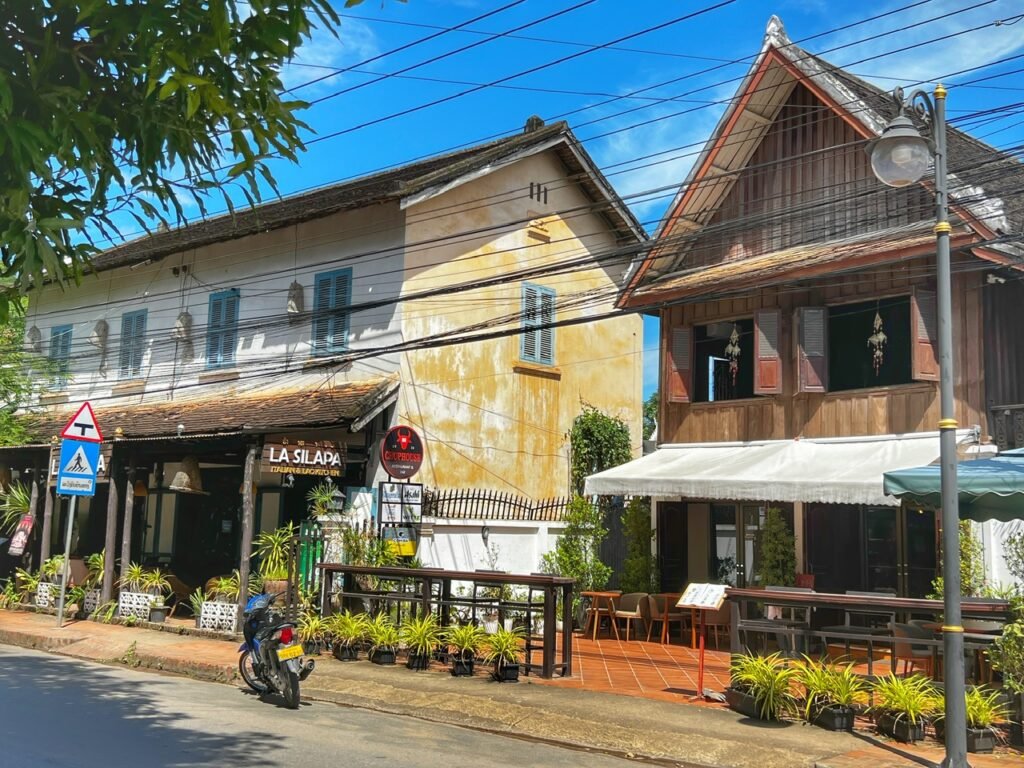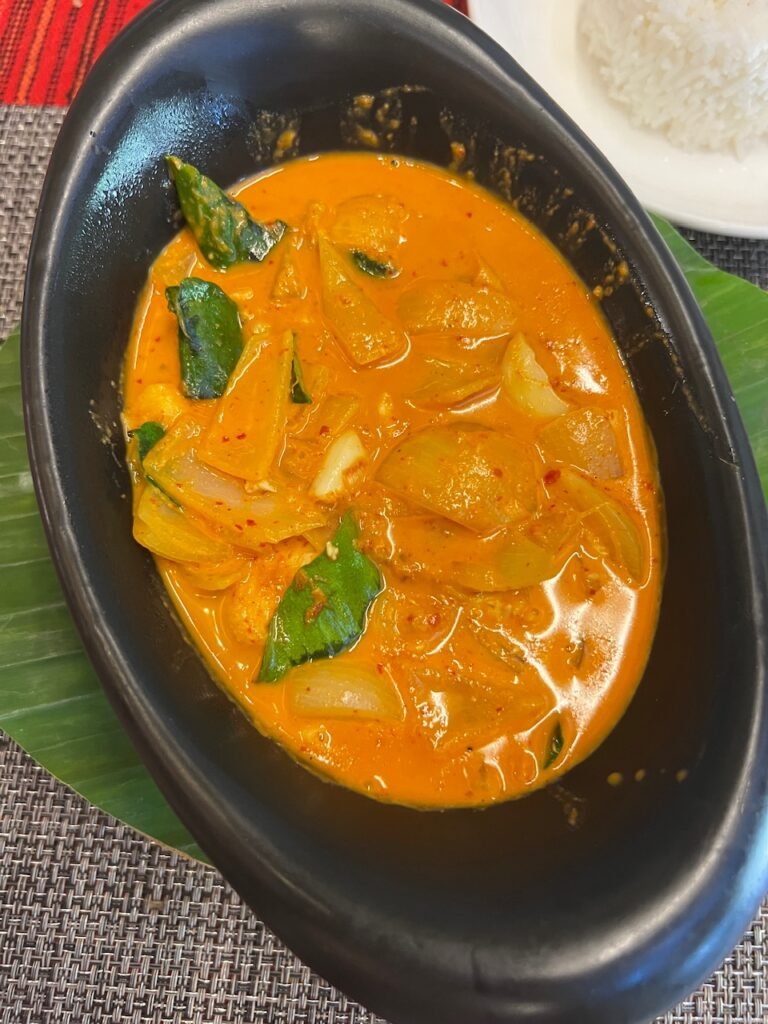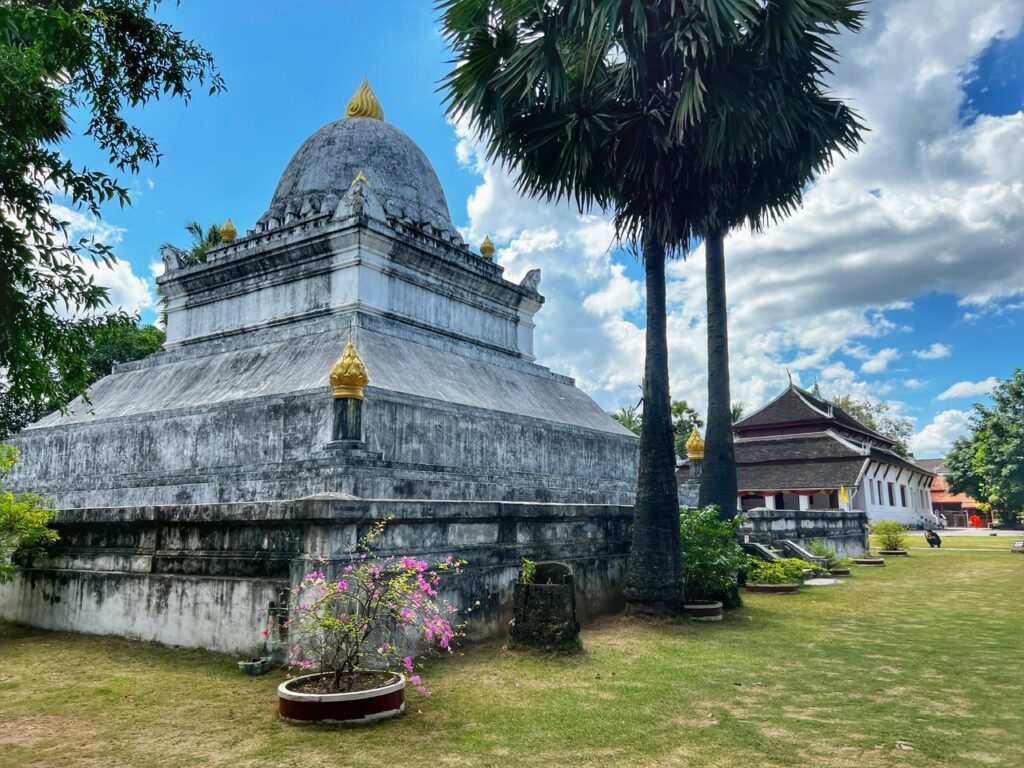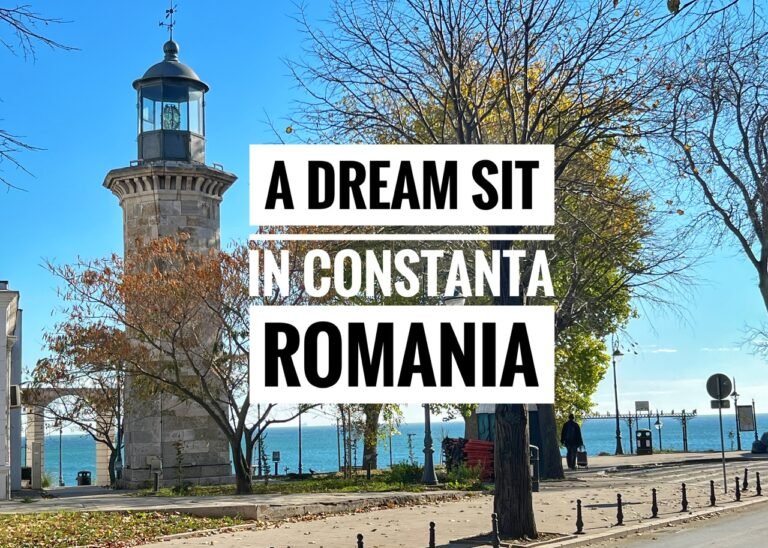
The Charm of Luang Prabang


Thanks to its cultural heritage, distinct spiritual vibe, culinary wonders and rich French colonial architecture, the UNESCO World Heritage jewel of Luang Prabang is a place that oozes culture, history, class, and charm at every turn. Therefore, it’s easy to understand why it has become an undeniable hit along the Southeast Asian traveler trail.
Unfortunately, it’s also become a hit along the mass tourism scale, as loads of Chinese tourists have found their way here, mostly due to the recently opened high speed train plunging straight into their country.
However, in the week we stayed, we discovered their rhythms and were mostly able to avoid them by avoiding the tourist attractions, especially on the weekends. This is just fine because this picturesque darling is best savored and adored for its vibe anyhow.
Luang Prabang is the undisputed cultural icon of Laos and a big part of that distinction is the architecture, which combines traditional Laotian design, as well as French colonial influences from the 19th and 20th Centuries. Everywhere you walk, you feel like you’ve stepped into some version of Europe blended with role models from other places and times.



It’s inundated with historic gems like this ice cream shop, classy hotels, and shops which appear to have had an Ottoman father.


What Hoi An is to Vietnam, Luang Prabang is to Laos…elegant and refined. Fortunately, Luang Prabang seems to lack a lot of the modern-day tourist kitsch that Hoi An has embraced. And, so long as you’re on two feet, and not trying to drive through the hundreds of tourist vans, it’s mostly very walkable and pleasant.


As you amble out of the main historic peninsula, the buildings continue to offer some swoonworthiness. Even this coffee shop, which is a Canadian chain, keeps its historic appeal, or this charming ATM which looks like it skiied out of a Swiss chalet.


Other than the tourist vans, the majority of the traffic is motorbikes, or Laos’ version of a tuk tuk which are mostly used as tourist taxis.


This could easily be in France. Speaking of France, there are an extraordinary amount of French people in Laos. As usual, they’ve all been immediately quite eager to talk to us about politics. Things have changed though in recent times (October 2024). Instead of laughing at us, they seem genuinely fearful for us…and themselves. It’s something we prefer not to be reminded us day after day as we roam these beautiful streets.



Our favorite time of day in Luang Prabang was taking our walks during the golden hour before the sun dipped at 5:45.

But by night, as soft music rolled out of the restaurants and the upper balconies flooded with people drinking actually quaffable wine included many magical moments. And continued to make us so grateful for OUR place and time in this unbelievable country.
The Cuisine of Luang Prabang
Luang Prabang is one of those places that is very easy to become enamored with. So long as you stay away from the tour groups, the serenity, the vibe, and the architecture are all just absolutely addicting and it would be very easy to stay a whole lot longer if we could afford a decent apartment. But another slam dunk for the town? Its cuisine. These gastronomic delights are diverse, inexpensive with terrific value, and absolutely delicious. Here we share some of our favorite meals…

On two occasions, because it was that good, we went to Tamarind Restaurant (and Cooking classes!) with Greg’s parents, which is clearly run by a true chef whipping up some dynamic menu items using local ingredients. Not only that, they offered some really unusual tasting platters so we got to try multiple options. Each time, the bill was about $40-50 for four of us, which included two carafes of delicious red wine, and enough food to feed the Laotian monk brigade. (No really…can we?!)
Mandy’s first meal included a salad trio featuring chopped fish and herbs, a papaya salad, and steamed local greens and veggies. ($5.24)


A “snacking” appetizer for the table includes Laos’ version of beer snacks…dried riverweed with sesame (the Mekong’s version of seaweed), fried mushrooms, rice cake (like a Rice Krispie treat minus the marshmallowy goodness), fried bamboo strips and normal things like peanuts and pumpkin seeds. Of all the choices, we found the bamboo strips the tastiest.
Greg’s first meal (middle) was called ”Five Bites” which included five popular Lao snacks including Luang Prabang pork sausage (Sai Oua), Leafy green vegetable pickle (Som Pak Gat), ‘Heavenly’ dried buffalo meat, sweetly flavoured (Sinh Savanh), Salad of minced pork, eggplant, banana flower with bamboo and sesame seeds (Sa Mak Keua) and Pickled bamboo shoots (jeow nor mai som) ($5.47).



On our second visit, we shared the vegan set meal which included: a Tofu laap, rice paper rolls with peanut dipping sauce and Tam mak tua, or Spicy green bean salad with ginger, as well as a make your own Miang plate which are lettuce wrapped rolls using the ingredients below it, a young pumpkin soup with somporn (a local leaf) for sourness, pea eggplants, basil and spring onion…


…a welcome liqueur shot called star rut teeur, which Grace had us be romantic as we drank it

….. and purple sticky rice with tamarind sauce and fresh fruit. All of this was an astounding $16 and was one of the best meals we’ve had in quite some time.


Oh, and of course we washed it down with wine carafes which were $6 each for decent quality French wine which were oh-so-thirsty for with our wonderful (and slightly inebriated) dinner companions.


After Greg’s parents left, we checked out Popolo Pizza with to die for SOURDOUGH crust. It was easily the best pie we’ve had in quite a while. It was $13 including two large draft BeerLaos. The Laotian food is great, but it’s always nice to be in a place like Luang Prabang so we can make sure our cheese food group is met.


We also accomplished our Indian food group at Fathima Indian which was mouthwatering. Greg’s thali was $5.50, and Mandy’s palak paneer was $3.50.

Surprisingly, our Asian subcontinent quota was not met so we also went to a Sri Lankan restaurant called Taste of Ceylon which wasn’t nearly as scrumptious, mostly because our Mysore Dahl was too salty. The pumpkin curry was quite nice though.



When we weren’t going international, we continued testing Laotian waters, including this Chicken Penang Curry from Khmu 2 ($3), or these vegetarian spring rolls ($3.42) from Jolie Vue which was a Laotian restaurant despite its French name. Green Curry Soup, also from Jolie Vue for $3.87.

After a big lunch, our dinners were almost always the same…a filling mango, avocado and yogurt shake for $1.60/each. Our smoothie boy’s smile was always complimentary.
Daily Life & Exploring Luang Prabang
As we’ve alluded to in other posts, perched along the edge of the Mekong, Luang Prabang is an utterly enchanting and elegant UNESCO World Heritage site; one that begs to be explored deliberately on foot and with no agenda. In fact, the name itself mean “Royal Buddha Image” which certainly feels appropriate. We stayed 7 nights, and then returned 3 more, which was far from enough. That said, stay as long as you can…it’s a decision you won’t regret.

Saying “sabaidee” to a t-shirt vendor and her quite literally cheeky daughter at the nightly market. Sellers are so friendly here, but never pushy. So far, we’ve found the best T-shirts in Laos that we’ve seen in all of SE Asia for less than $3/each. We each topped up with two and said goodbye to those with some faded glory.


The “Old French Bridge” motorbike and pedestrian thoroughfare which crosses the Nam Khan River and connects the historic peninsula to reality. The other pedestrian bridge has unfortunately been destroyed in the flood so getting to and from our first accommodation with Greg’s parents always required a long walk or taxi. The walking path on the motorbike bridge hugged the opposite edge to ensure safety. You have no idea what a luxury item this is. 🤣

If you don’t see multiple golden Big Buddhas in Laos, you’re doing it all wrong.

A meditation garden at one of the many wats. There are over 30 Buddhist temples in Luang Prabang.

A sea of red and blue canopies at an overlook of the night market which takes places every night and extends for what seems to be infinite blocks.

A Laotian long boat heads south at the crossroads of the Nam Khan and Mekong Rivers.


Wat Wisunnarat is one of the oldest in Luang Prabang and dates back to the 16th Century with its watermelon nicknamed stupa. Nearby, an ancient gate connecting it to its shiny new 19th Century neighbor.

Laotian stop sign. The squiggly blobs of Laotian letters, like Thai letters, both arrive from Old Khmer script, which came from India. However, they have slight differences in appearance, pronunciation and usage.


Of the 7.4 million people which live in Laos, there are four major ethic groups: the Akha, (H)mong, Khmu, and Laos identifying an ethnic group, but each contains distinct branches which may differ markedly in language, dress, geography and customs. For an outsider, it’s much easier to identify them based on their attire.
These Akha hats, which look like a very dignified version of an elementary school Pom Pom craft project are certainly memorable. They, and other traditional costumes can be seen at the Traditional Arts and Ethnology Centre, which was worth a visit.


One tourist thing we did do was head up Pousi Hill for a night time view of Luang Prabang and the Mekong.

Santa really wouldn’t enjoy the sweeping roof Haw Phra Bang.


The night market is undoubtedly one of the most packed places in Luang Prabang in the evening. Visiting twice was way too much for us as more than 50% of the tables were blocks of Chinese tour groups. And at least 10% of that 50% had their long lens cameras in direct shooting range of us… or other white people. 🤣 And afterward, the mobs trying to find their designated white van while others simply try and get a taxi tuk tuk to take them to their hotels. Uh. We’ll walk… thanks.

Speaking of taxi tuk tuks, check out this cute little chauffeur. In our opinion, Laotian kids rival Nepalese in the cutest category.



But the wats, like Sensoukharam, definitely have more flair than those in Nepal, including a monk long boat dry docked at the wat.

Rice cakes drying in front of the wat. These are a staple snack food in Laos and though they’re not coated in white cheddar Parmesan, are satisfyingly crunchy.

A wedding photo shoot we stumbled upon on the historic peninsula. We later ran into the same couple and found out they were from Charlotte, North Carolina, but having their wedding in her mother’s land of Laos. She’s from the Hmong tribe. So fascinating!


More long boats…luxury versions that head out for sunset cruises, as well as the slew of white mini vans that cart around the tour groups. If you saw a cluster of them, it was generally a good idea to avoid this area until they parted ways.

A tragic, but true reality of living in this part of the world. At the night market, a vendor selling bracelets that were formerly bombs. The sign says: “These bracelets were bombs. We make bracelets not war. Our bracelets are made from the aluminum dropped on our country during the secret war since 1964 -1975. After war someone taught us what to do with the bombs that destroyed our lives. From bombs we made souvenir such as spoons, rings, chopsticks, bracelets, bottle opener and other… We began to form bombs in to beautiful bracelets. We bring the new meaning bombs and help ourselves and escape poverty.”

Other colorful pops at the night market. The change purses on the right look like pages of a children’s book… clearly either made by children, (or by less talented adults.🤣) Regardless, they’re adorable. We especially liked the public service reminder that “a dog is a kind of pet” after the things we saw in North Vietnam.

Hanging out with fellow American nomads Alicia, Wes, Justin and Launa. It’s always nice to meet people that “get” our lifestyle.

A Laotian pharmacy. Even in the former capital of Laos, don’t hope for a lot!

An outfit that Mandy would undoubtedly own if she still went into an office.


Far less chaotic and touristy than the night market is the morning market, which is practically the same as the chip aisle in any US supermarket. But, instead of Doritos, Cheetos and anything else ending in an -O, you’ll find fried bamboo shoots, fried mushrooms, and dried riverweed. We tried all this at Tamarind Restaurant. If you’re gonna splash out, we’d recommend the bamboo.



Or, what appears to be potpourri, is actually Bael Tea, made from the fruit of the same name. The Bael tree is considered a sacred tree by Hindus since they associate it with Lord Shiva, one of their supreme gods. Another option is dried buffalo skins. Uh. No.
Way more appealing to us was this pile of varied goodness although we don’t know what several of these things, nor do we have a kitchen. They also confiscated our newly purchased fruit knife at the train station, so once again during fast travel, we’re frustratingly at the mercy of restaurants.

Also seen at the morning market, at a local coffee stand. The world was watching and waiting in early November 2024. They wouldn’t be at all happy with what was to come.
Garavek Storytelling Experience


If you’re looking for a unique cultural experience in Luang Prabang, check out the Garavek Storytelling Theatre. Every night at 6:30 pm, an animated narrator and his khene-playing companion reveal tales of Laotian folklore and myths in an intimate little theatre the size of a shoebox. The khene is a bamboo mouth organ which creates a mesmerizing melody as the stories are told in English, which help travelers understand the mysticism and legend behind this remarkable country. The show lasts an hour and costs 120,000 Kip, or about $5.50. Seats are first come, first served so arrive early. Beer, wine and sodas are available for sale as well! Just another lovely experience this divine town has to offer!
Daily Alms Ceremony

As I wrote this section on October 31, it was difficult not to draw parallels as I edited photos of young boys in orange-colored robes with outstretched bags requesting “treats” from random strangers. However, the daily alms ceremony, or Tak Bat, in Luang Prabang is hardly a Halloween affair. In fact, it’s been going on for more than six centuries and is deeply rooted in Buddhist and Laotian tradition.
Every morning at sunrise from about 5-6:30 am, hundreds of monks from the local monasteries shoelessly amble in single file along the swept streets to receive offerings of food from local people and (hopefully respectful) visitors. This ancient tradition reflects the values of humility, devotion, and compassion in Buddhist practice, as the alms provided help sustain the monks, who rely completely on the community for their daily sustenance.
Unfortunately, due to the influx of mass tourism…the ceremony has became a bit of a papparazzied spectacle and to us, it felt downright…cringy. We can hardly imagine how the monks must feel.


However, you should know the street where Garavek Storytelling is located has a very different vibe than Sakkaline Road and is where you find most of the locals. It is on this street where the monks likely receive the food they actually eat.
The ceremony is seen as a sign of mutual respect. In the Buddha’s time, monks were expected to live humbly, relying on the generosity of the community for sustenance rather than preparing food themselves.


This was seen as a way for monks to focus on spiritual practice without becoming attached to worldly possessions while local people, like this group today, accumulate good karma for giving to the monastic community. Observing these local people felt right, as they gave monks steamed fish in banana leaves and fresh sticky rice… a vastly different experience to what would come next.

One street over was a veritable zoo of smartphones getting way too close to the monks, vociferous jabbers in the most foreign language of them all, and inappropriately dressed westerners, all despite what the signs indicate is appropriate behavior.

Guidelines include dressing modestly, maintaining silence, refraining from physical contact with the monks, and taking photos from a distance.


What was once a serene and reflective ritual has morphed into what probably feels like “Tourists Gone Wild” from a monk’s perspective. Needless to say, the ceremony’s sacredness is being destroyed.
The monk’s offerings from the visitors include two things: heaps and heaps of sticky rice, which is a traditional offering and the 20th Century convenience contribution…processed “Yumeo” candy bars. What?! No Reese’s Cups or Snickers?


We were a bit horrified that this was meant to serve as the monk’s daily sustenance until we realized they were tossing all of it in bins along the way, which evidently will be picked through and resold to naive tourists the next day. I wonder if this brings the monks a bit of silent (not-so-humble) joy to dump this “food” directly in front of we tourists?

Fortunately the blobs of the rice are being served into outstretched bags with gloved hands. Was that a Covid change or has it been around awhile?


There were so many of them. We’ve never seen anything like it. In fact, have we ever seen this much orange…period?! We’ve also never seen so many Chinese people. For the record, not all the tourists were misbehaved. Some of them appeared to be present, not on their phones and fully respectful of the ritual.

The vendors selling these offerings are also a new thing which is disruptive to the ceremony. Oftentimes, this food is old and poor quality as aforementioned.


Most boys become monks for two main reasons. The first is to cultivate merit (good karma) and to honor Buddhist teachings. The second is for educational opportunities they wouldn’t have otherwise, especially those that come from rural communities. A group of Ajahn, or teachers, of the monks.

Yumeo.


A lone monk amongst the chaos. And to think they do this…every. single. morning.

A group of Chinese tourists wait excitedly for their turn to make the monks further stagger under the weight of all those Yumeos and rice.


As everyone dropped their vacated baskets of sticky rice, you could almost feel the monks’ sighs of relief as they turned the corner to the adjoining street. With a little more pep in their step, another morning was over as they returned to their monasteries.
Our Accommodation(s)
After nearly a week down in the adventure capital of Laos, we headed back to the national treasure of Luang Prabang a few nights before working our way to the north of the country for the remainder of our time. Because of this, we’ve moved into our third hotel in the town and have gotten three distinct flavors of the neighborhoods. Although we love them all, the area south of the historic peninsula feels like our favorite because there are fewer tourists, it’s super quiet and it’s still walking distance to everything.


Our first hotel, which we stayed at with Greg’s parents, was at the way-out-our-price range Apsara Rive Droite, which as the name indicates for the multiple visiting Frenchies, is on the right side of the river. The $162/night may have been worth it though because of the Thai manager, Han, who might have been the most endearing man we’ve ever met with his wispy voice and kind-hearted demeanor, as well as his hospitable staff.


Our giant cartwheelable room, donned in dark rosewood, was very dark, but had an absolutely perfect sleep included in the price, as well as a swimming pool, I mean tub, the bathroom…


…and a large balcony with rare cushy seats overlooking the Nam Khan River, as the Explorer Genes welcome you to “lifestyles of the rich and famous.”


Our daily breakfast offerings. What is it about poached eggs that make them so hoity toity?! 🤣

After the parents left, it was back to reality, so we relocated to “Mekong Charm Riverside” on the historic peninsula for $28/night which in our opinion, was quite adequate considering the $134 in savings. The room was quiet, beautiful and spacious and had a cozy bed. The only downside was the smurfy blue glow that was cast throughout, due to a heat shield on the balcony. 🤣 So, again, it was dark, which is great at night but not so much when you’re working by day. They like it dark in Laos, we’re learning.



It also included a breakfast of fruit, and seven breakfast choices including a yogurt/fruit/granola bowl or eggs. But, the best part was our breakfast/work station overlooking the Mekong.

We arrived to our final Luang Prabang hotel, Opera Premier Hotel, on November 2, after the obvious price hike that kicks in for Laos high season beginning November 1.


Yet, thanks to “Genius Level 3” discounts, on Booking, we got a spacious family room upgrade, and not 7 but 10 breakfast choices, including a real baguette (thanks French colonizers) for $25/night. We also got to look at ancient wats outside our hotel window, which was really not a terrible view…



